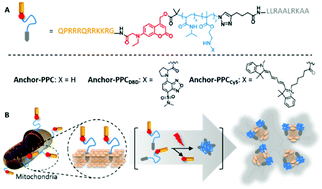A photocontrollable thermosensitive chemical spatiotemporally destabilizes mitochondrial membranes for cell fate manipulation†
Abstract
Perturbations in mitochondrial membrane stability lead to cytochrome c release and induce caspase-dependent apoptosis. Using synthetic smart chemicals with changeable physicochemical properties to interfere the mitochondrial membrane stability has not yet been reported. Here we show that a thermosensitive anchor–polymer–peptide conjugate (anchor-PPC) destabilizes mitochondrial membranes upon in situ molecule changes from hydrophilic to hydrophobic, which consequently induces apoptosis in a spatiotemporally controlled manner and acts as an antitumor pharmaceutical. The anchor-PPC is composed of a thermosensitive copolymer, a photolabile linker, a hydrophilic HIV Tat-derived peptide both for cell penetration and polymer phase transition temperature (Tt) modulation, and an anchor peptide for intercalating into mitochondrial membranes. The photocontrollable anchor-PPC dehydrates and changes from being hydrophilic to hydrophobic upon photoactivation at body temperature. This cell-penetrable anchor-PPC specifically targets mitochondria and destabilizes mitochondrial membranes upon irradiation, and consequently initiates apoptosis in cells and a complex 3D tumor model. This study provides the first experimental evidence that the synthetic smart chemical can spatiotemporally control the stability of organelle membranes based on its in situ physicochemical property change.



 Please wait while we load your content...
Please wait while we load your content...